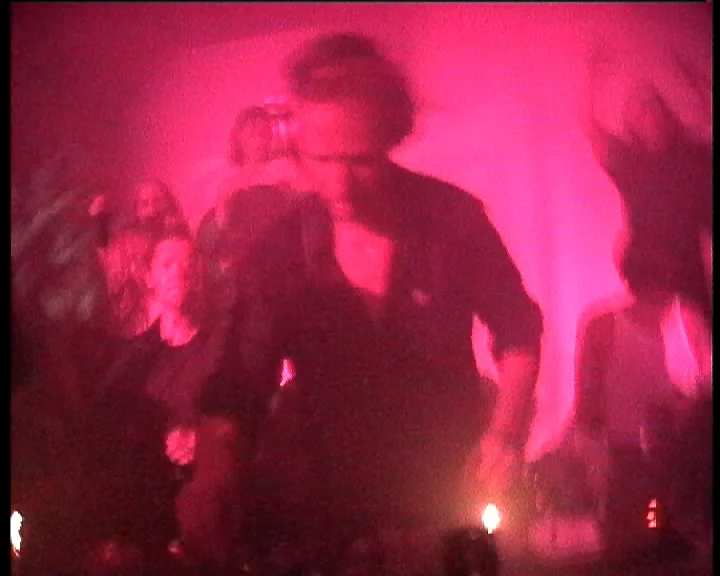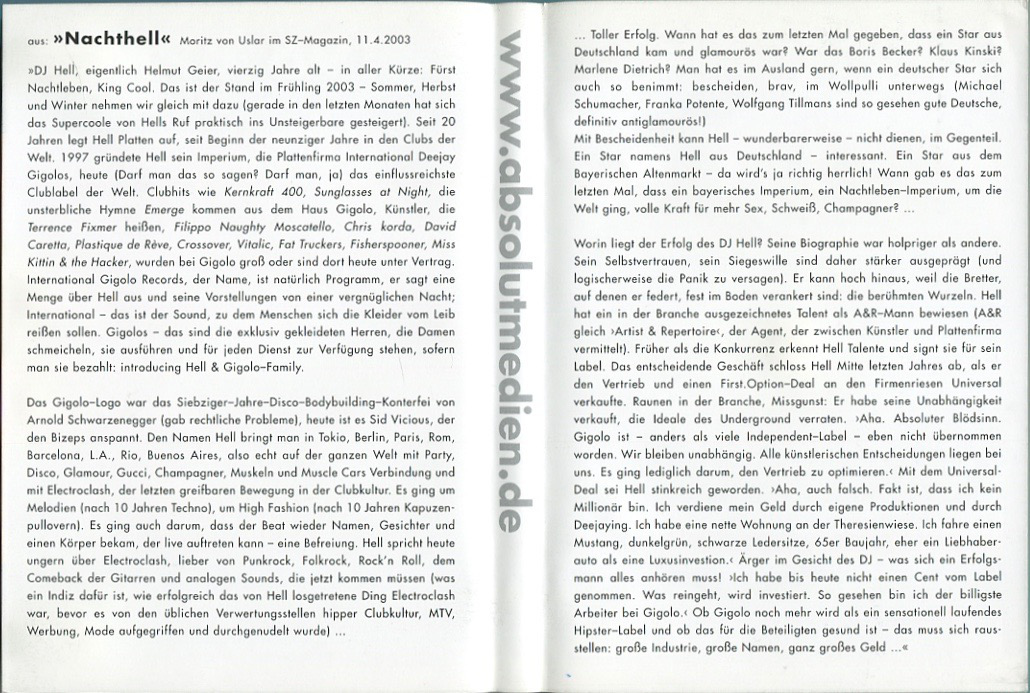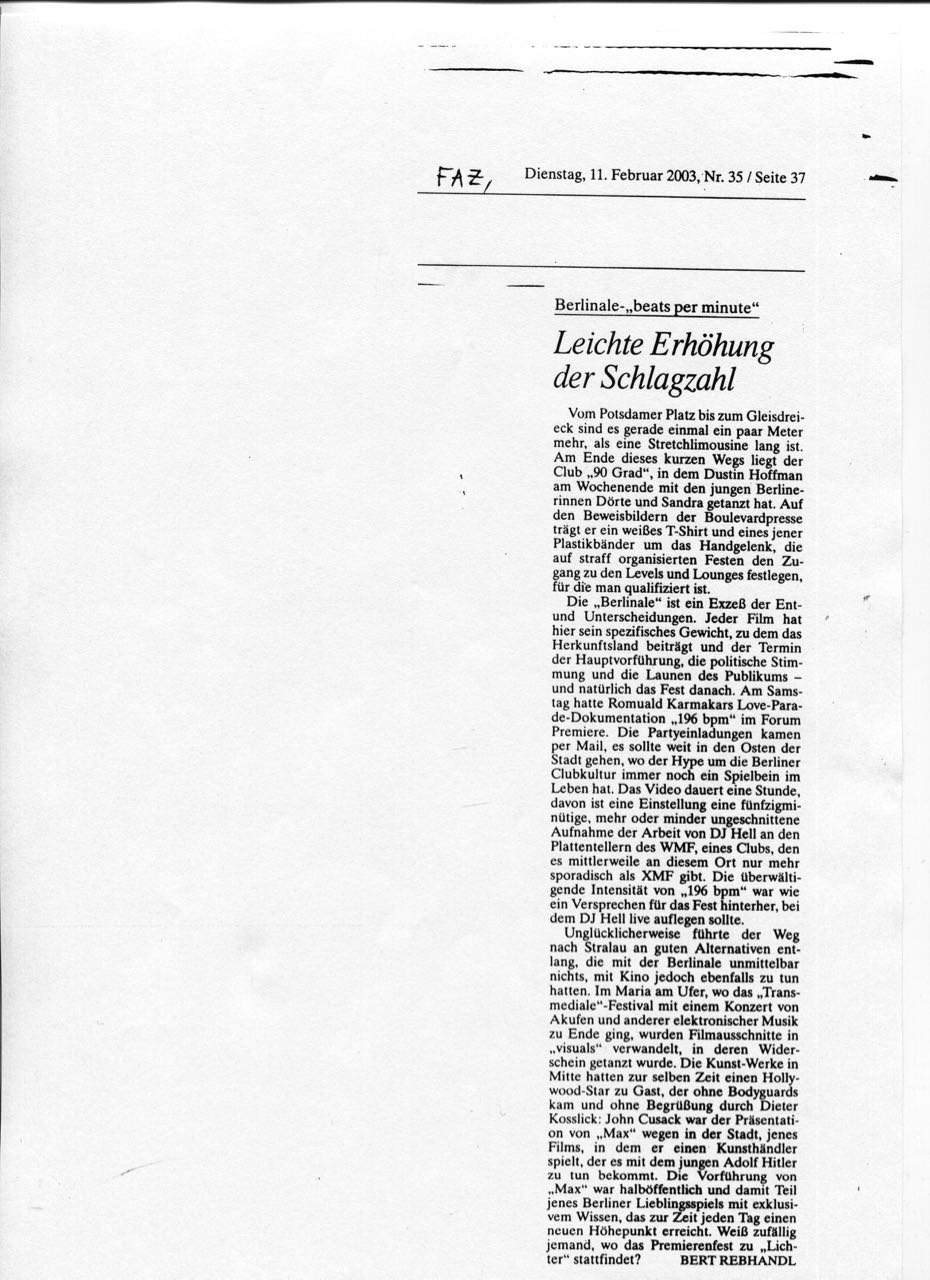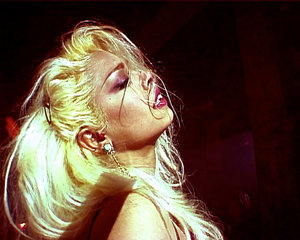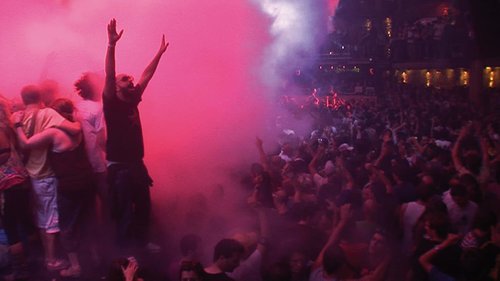196 BPM
Deutschland 2002, 62 Min
Cast: DJ Hell
Regie, Kamera, Produzent: Romuald Karmakar
Schnitt: Uwe Klimmeck
Produktion: Pantera Film GmbH
Bild/Ton: Mini-DV/Digi Beta, Farbe, 4:3, Stereo
WP: Berlin Int. Film Festival, Forum, 2003
DVD / Absolut Medien
Verleih / Pantera Film GmbH
SYNOPSIS / D
Die Loveparade 2002 in drei Einstellungen:
INTRO
Freitag Abend, Breitscheidplatz. Jemand tanzt wie ein Gummiball. Andere kommen vorbei und tanzen mit.
GABBA
Unter dem Druck von 196 bpm wird aus einer Dönerbude ein Ort der heiligen Raserei.
HELL AT WORK
Montag Morgen im alten WMF. Es ist Gigolo-Night und DJ Hell legt auf. Die meisten Gäste feiern bereits seit Tagen. Am Ende sind alle bereit für Marilyn Mansons «Tainted Love»...
SYNOPSIS / E
The documentary of the 2002 Berlin Love Parade, from the perspective of three sites on the hidden sidelines of this techno jamboree. Using one uninterrupted shot apiece and without dialogue or commentary, the director uses the original sounds and sites, consisting mainly of music and a few scraps of overheard conversations. Karmakar’s film collects impressions of the various musical styles that fall under the loosely defined term «Techno». The music, the dancers, the locations and a DJ take the foreground here. The first Love Parade took place in 1989 with just 150 participants. In 2002, well over half a million participants «demonstrated» in the event described officially as a House Music Demonstration for Tolerance, Respect and Understanding among Nations. – Catalogue, Göteborg Film Festival 2004
ZUM FILM
Romuald Karmakar dokumentiert in 196 BPM (bpm: beats per minute) das Geschehen an drei Nebenschauplätzen der Berliner Love Parade 2002. Die drei unkommentierten, dialogfreien und mit Mini-DV jeweils in einer Einstellung gedrehten Teile des Films geben den Originatton wieder, der hauptsächlich aus Musik und wenigen Gesprächs- und Wortfetzen besteht. Anders als die üblichen Dokumentationen über die Love Parade, in denen über Besucherzahlen, Drogenmissbrauch, Verunreinigung der Stadt, Ruhestörung etc. berichtet wird, versammelt Karmakars Film Impressionen der verschiedenen musikalischen Stilrichtungen innerhalb des schwierig zu definierenden 'Techno'-Begriffs; die Musik, die Tänzer, die Orte und ein DJ stehen hier im Vordergrund.
1989 fand die Love Parade mit zunächst nur einhunderfünfzig Teilnehmern zum ersten Mal in Berlin statt. Seither hat die Veranstaltung unter dem Motto 'House-Musik-Demonstration für Toleranz, Respekt und Verständigung zwischen den Nationen' jedes Jahr mehr Menschen angezogen; 2002 sollen weit über eine halbe Million Teilnehmer 'demonstriert' haben. Die Veranstaltung versteht sich selbst als offenes Forum für die internationale elektronische Musikszene. Techno, der überbegriff für die unterschiedlichsten Spielarten elektronischer Musik, ist in all seinen Variationen in allererster Linie Tanzmusik.
Der erste Teil des Films (Intro, 3 Minuten) zeigt den Bereich vor der Eingangstür des Clubs 'Linientreu'. Mit Lautsprechern wird Musik aus dem Innern auf die Straße übertragen. Ein junger Mann tanzt wie ein Gummiball, Menschen laufen vorüber, tanzen mit.
Der zweite Teil (Gabba, 7 Minuten) führt den Betrachter an den Breitscheid-Platz, wo in einem umgeräumten Döner-Imbiss ein Pult aufgebaut ist. Draußen wird unter dem Druck von 196 BPM wild getanzt.
Der dritte Teil (Hell At Work, 50 Minuten) beobachtet – ebenfalls in einer einzigen Einstellung, die nur einmal unterbrochen wird von einem 350-Grad-Schwenk – den in der Techno- und House-Szene bekannten DJ Hell bei der Arbeit. Es ist Gigolo-Night im alten 'WMF', einem legendären Berliner Club, und die meisten Gäste feiern bereits seit Tagen. In rotes Licht und Stroboskop-Effekte getaucht, legt der 1962 als Helmut Josef Geier geborene Münchner DJ unter anderem Coverversionen von Depeche Modes 'Behind the Wheel' und Soft Cells 'Tainted Love' auf – Stücke, deren Originalversionen er in den achtziger Jahren hörte, die aber sein heutiges Publikum zum großen Teil nur noch in den neu gemischten Fassungen kennt. – Tanja Horstmann, Katalog Berlinale 2003 (Forum)
ABOUT THE FILM
196 BPM is Romuald Karmakar's documentary of the 2002 Berlin Love Parade, from the perspective of three sites on the sidelines of this techno jamboree. Using one uninterrupted shot apiece and without dialogue or commentary, he uses the original sounds of the sites, consisting mainly of music and a few scraps of overheard conversations. Unlike the usual documentaries about the Love Parade, which focus on the number of participants and the chaos and litter they leave behind, drug abuse, noise pollution, etc., Karmakar's film collects impressions of the various musical styles that fall under the loosely-defined term «Techno.» The music, the dancers, the locations and a DJ, take the foreground here.
The first Love Parade took place in 1989 with just 150 participants. Since then, the event, described officially as a «House Music Demonstration for Tolerance, Respect and Understanding among Nations,» has drawn more and more people. It was estimated that in 2002, well over half a million participants 'demonstrated." The event's organizers consider it to be an open forum for the international electronic music scene. Techno, the umbrella term encompassing various genres of electronic music, is first and foremost dance music. The first part of the film («Intro»: 3 min.) shows the area in front of the entrance to the Linientreu nightclub. Loudspeakers pump music out of the club's bowels onto the street outside. A young man dances like a rubber ball, passers-by dance along.
The second part («Gabba», 7 min.) takes the viewer to Breitscheidplatz, where a DJ's mixing desk has been set up in a requisitioned kebab stand. Outside, the revellers are dancing wildly under the pressure of l96 bpm.
The third part («Hell at work»: 50 min.) is another single-setting shot, though this time interrupted once by a 360-degree pan, focussing on techno and house DJ Hell doing what he does best. It's Gigolo Night in the former WMF, a legendary Berlin nightclub, and most of the dancers have been partying for days. Bathed in a red glow and flashing strobe tights, the Munich-based DJ (christened Helmut Josef Geier in 1962) plays cover versions of Depeche Mode's 'Behind the Wheel' and Soft Cell's Tainted Love; tracks he listened to in their original version in the 1980s, but which most of his current audience only knows in their new, remixed forms. – Tanja Horstmann, Catalogue Berlin Film Festival 2003 (Forum)
